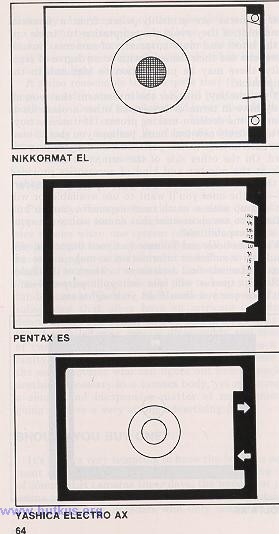Aperture Priority 35mm cameras
This camera manual library is for reference
and historical
purposes, all rights reserved.
This page is copyright©
by
 ,
M. Butkus, NJ.
This page may not be sold or distributed without
the expressed
permission of the producer.
I have no connection with any camera company.
,
M. Butkus, NJ.
This page may not be sold or distributed without
the expressed
permission of the producer.
I have no connection with any camera company.
On-line camera manual library
Back to main on-line manual page
If you find this manual useful,
how about a donation of $3 to:
M.
Butkus, 29 Lake Ave.,
High Bridge, NJ 08829-1701
and send your e-mail address
so I can thank you.
Most other places would charge
you $7.50 for a electronic copy
or $18.00 for a hard to read Xerox copy.
This will help me to continue to host this site,
buy new manuals, and pay their shipping costs.
It'll make you feel better, won't it ?
If you use Pay Pal, use the link below.
Use the above address for a
check, M.O. or cash.
www.PayPal.me/butkus
CLICK HERE FOR
Aperture Priority 35mm cameras
PDF VERSION - EASIER PRINTING
35mm SLR EE
Selection Guide
Aperture-Priority
|
INTRODUCTION 2
THE APERTURE-PRIORITY SYSTEM
PROS AND CONS
The Future
MINOLTA XK
NIKKORMAT EL |
PENTAX ES
YASHICA ELECTRO AX
MORE ON THE WAY
What Does It All Mean?
Should You Buy One?
|
INTRODUCTION
Progress towards exposure automation has been slow, but since
the original Konica Autoreflex appeared in 1968, the pace has accelerated and
there are now 10- 35mm SLR cameras so equipped. Under normal circumstances,
there would be little difficulty in choosing the one that seems "best" for your
photographic needs, but the introduction of the electronically governed shutter
and the aperture-priority exposure system by Pentax in 1971 has thrown the
consumer into a quandary - which system is best for him, the shutter priority or
aperture-priority?
It's not a decision to be made lightly, as a substantial sum of
money is involved in purchasing an SLR EE camera, and you should be certain that
you've made the right decision when you tell the clerk to "wrap it up." So
Photographic magazine decided to provide sufficient comparative data to help you
decide if automated exposure is the right path for you and if so, which camera
will best suit your particular needs. As a careful evaluation of all 10 cameras
currently available proved to be beyond the scope of a single volume in the Mini
Manual series, the topic was sliced in half - you'll find the Aperture-Priority
cameras in this volume and those using the Shutter-Priority system in Volume I.
If you've already decided which system to go with, this book will be sufficient;
if not, you'll want both for the complete picture. Now, let's take a look at
what makes the "electronic" cameras tick.
THE APERTURE-PRIORITY SYSTEM
This approach to automated exposure appeared in late 1971 when
Asahi announced its new Pentax Electro Spotmatic (ES) camera. The Asahi system
lets the user preselect the aperture setting desired, and the camera's metering
circuit then chooses the correct shutter speed. While the shutter-priority
cameras rely upon conventional mechanical linkages to transform the meter
reading into exposure automation, the Pentax aperture-priority system puts the
latest advances in micro-electronics to work, turning the job of control and
correction over to Integrated Circuit (IC) chips.
Mechanically governed shutters operate on a step basis; that is, each shutter
speed gives 50% less exposure (starting from 1 second) than the preceding speed.
By adding an electronic governor to the focal plane shutter, it becomes possible
to produce a stepless shutter in which speeds are infinitely variable, and
chosen according to the requirements specified by the meter. This means that
instead of calculating exposure in terms of the required aperture, as set by the
user, and a corresponding mechanical shutter speed "block" (1/60, 1/125,1/250,
1/500-second, etc.), this new breed of shutter can open and close at any speed
it is told to - 1/47, 1/83, 1/166, 1/291-second, or whatever precise speed is
determined by the meter as being optimum for the subject and light conditions at
hand.
Basically, an aperture-priority SLR works like this-- after keying the film
speed into the meter to determine its sensitivity level, the lens aperture is
set. When the meter is turned on, information about the preselected aperture is
sent to the primary electronic center through a variable resistor attached to
the aperture stop-down ring. This information is joined by data about the film
speed, which is transmitted by a multifunction resistor. At the same time, the
CdS cells begin measuring subject light intensity and sending this data to the
electronic center, where it's stored in a capacitor which acts as a memory bank.
When the shutter is activated by pressing the release in
completely, the lens stops down to the preselected aperture as the mirror flips
out of the way and the first shutter curtain begins its travel.
TYPICAL SYSTEM

When the camera's metering circuit is turned on, its control center
receives information about film speed, lens aperture, and light intensity.
Depressing the shutter release closes a switch to the control center, which then
energizes the electromagnet that will hold the second curtain.
The lens stops down to its preselected aperture as the mirror rises and
the first shutter curtain begins its travel. The CdS cells are now disconnected
and the control center's memory capacitor takes over. The timing capacitor draws
battery energy until its load equals that of the memory capacitor.
When equality is reached between the two the electromagnet is
de-energized and releases the second curtain to end the exposure. The mirror
returns, diaphragm opens up to full aperture and CdS cells begin monitoring the
light level once more.
The CdS cells are temporarily disconnected from the control circuit, turning
over their function to the memory bank. Battery power is diverted to an
electromagnet, which restrains the second curtain, and to a timing capacitor.
When the capacitor and electromagnet charges become equal, the control center
de-energizes the latter, which then releases the second curtain to complete the
exposure.
Thus, what we really have is a mechanically operated, electronically governed
shutter, not an "electronic" shutter as some manufacturers might lead you to
believe. By energizing the electromagnet, the shutter is trapped open until
battery and capacitor resistance is equal - the so-called trigger level - at
which time the electromagnet is de-energized to close the shutter. The length of
time needed by the timing capacitor to reach the trigger level is dependent upon
the resistance value used in shutter speed selection. In elementary
applications, this could be a variable resistor, but it usually takes the form
of a complicated network of resistors for film speed, aperture control, and for
light level responses.
While it's possible to provide the user with a visual readout in the viewfinder
as to the shutter speed chosen by simply attaching a needle to a moving coil
meter, not all aperture-priority systems are designed to do so. The Pentax ES
does, but in an effort to be the first with the most, the trend seems to be in
the direction of light-emitting diodes. These require far less space and are
also less fragile than a moving coil, but are currently limited to performing
the function of indicating over/underexposure. But as fast as this field is
moving these days, it's dangerous to make statements like the above - the next
AP SLR EE to appear might well feature a full array of such diodes.
As you might imagine, the aperture-priority system requires more battery power
than the shutter-priority cameras - 3.0 to 6.0 volts as opposed to 1.35 to 1.5
volts. If the battery voltage level drops below a predetermined level, the meter
stops functioning, and you must resort to manual operation until the battery can
be replaced. With some designs, you're limited to a single speed (usually
1/1000-second under such conditions) while others allow you the luxury of a
variety of speeds.
This brings us to the manual override built into the aperture-priority cameras.
Each has a range of speeds at which the focal plane shutter will operate
mechanically on a step basis, allowing you to use the camera manually or in a
match-needle mode. Some designs also have an exposure compensation subsystem
that programs the main system to provide over/underexposure as much as two
f/stops for use under special lighting conditions.
PROS AND CONS
As mentioned in Volume I, the shutter-priority system is a
proven one whose mechanical linkages derive from those used in countless
match-needle SLR's. All is not lost should the meter battery fail, as you can
use the camera manually by selecting your own aperture until a new battery can
be obtained and installed.
But the system's disadvantages are threefold. Each lens used with a
shutter-priority camera must incorporate a coupling device to function with the
manufacturer's design; thus, a lens used with a Konica Autoreflex will not work
on a Miranda Auto Sensorex EE body. Lenses, extension tubes, extenders, etc.,
will not work automatically with camera bodies other than the one for which they
were designed. And as all manufacturers do not provide the same flexibility in
terms of number and types of lenses available for their body design, this can be
a limiting factor in your choice of camera.
Although the diaphragm stopping device controls the aperture selection with only
a limited amount of movement, mechanical wear leading to a loss of adjustment
can throw off the aperture by a full f/stop or more without the meter or you
ever knowing it. But the shortcoming most discussed by amateurs and the
photographic press is the point at which the shutter priority camera is locked
into a selected exposure. Once the needle is trapped, the aperture selected by
the meter can be changed only by freeing the needle and remetering. This means
that pressure on the shutter release must be removed, the linkage configuration
returned to its original position, and the process started all over again.
What does this process mean in practical terms for most of us? Well, if you trap
the needle and complete the exposure, it means very little. Despite what self
styled authorities claim as a valid criticism of the shutter-priority system,
that brief time between the point of no return and the opening of the shutter is
inconsequential. The possibilities of lighting conditions changing sufficiently
to spoil your shot in that split-second are so slight as to be nonexistent with
all but the most unusual of subjects. What you must remember with this type of
exposure automation is to not trap the needle, and then to wait several seconds
before completing the shutter release travel. If you trap the needle and do not
continue through with the exposure, release the pressure on the shutter button
until you're ready again to expose, and then do so with a smooth motion.
Proponents of the aperture-priority system maintain that exposure is more
precise with this system because of the memory bank which stores exposure data
right to the moment of mirror rise. They also maintain that shutter speed
increments can be more minutely divided and controlled by an electronically
governed shutter than can the differences between apertures operating via a
trapped needle system. For all but the professional, these are academic
arguments. However, one very solid fact about the aperture-priority cameras
remains hard reality to be considered carefully before reaching a decision as to
which camera to buy: You can obtain exposure automation with any lens that fits
the camera because no special lens mount is required as in the shutter-priority
system.
Although the so-called "electronic" camera is less subject to temperature and
humidity factors, there remains to be answered the all-important question of
gradual changes in the components that make up the electronic system. Over a
long period of time, there may be alterations in the capability of the memory
bank and timing capacitor, or resistors may experience a value change. In either
case, incorrect data would operate the system without the user or the control
center being aware of what had happened, resulting in incorrect exposures. These
are questions to be answered over the next few years, but you can rest assured
that as soon as they appear (if they do), manufacturers will correct any
problems.
Those who worry about selecting an aperture that will result in such a slow
shutter speed as to capture subject movement as a blur, can look upon the
aperture ring as a means of controlling the shutter speed, not the F-Stops. This
bit of mental double-thinking will work fine with aperture-priority cameras like
the Pentax ES, which gives a visual indication of the shutter speed chosen, but
will not work so well with the Yashica Electro AX, which does not. Users of such
"blind" aperture-priority cameras can double-think themselves into working with
near-maximum apertures (except where depth of field is critical) to assure a
high shutter speed.
THE FUTURE
Will the electronically governed cameras eventually "do in" the mechanical
competition? Probably not; the electronics that go into an aperture-priority
camera are currently considerably more expensive,
and you pay for this high degree of sophistication with hard cash. While the
market for such cameras is a potential 1/2 to 1/4 million annually,
it will never expand sufficiently to bring about widespread price reductions as
a benefit of mass production.
Even if electronics sweep the photographic market in the next few years, the
economics of producing a mechanical-linkage, shutter-priority camera will
probably assure this system of retaining at least the lower half of the market.
Since every one of these cameras is manufactured abroad, the precarious position
of the dollar, the threat of unfavorable trade balances, and a possible further
devaluation of currency in the future is almost certain to drive the price of
both systems upward--the list price of an Electro AX equipped with the f/1.2 is
already $600.
In the coming months, you'll be reading a lot of arguments concerning which
system is the best--shutter or aperture-priority. Actually, there is no "best,"
and your consideration of the cameras included in this selection guide should be
based, as always, on what purpose you intend to use the camera for, and how much
money you can afford to spend.
One last word--all cameras included within these pages are the manufacturers'
top-of-the-line and of professional caliber. You'll find no optical comparisons
of lens tests included; each camera's lens will deliver a professional quality
picture and the mumbo-jumbo of such tests means very little to the average
reader.
For all but the most demanding professionals, the primary difference between the
lenses offered for the cameras discussed within these pages is one of
construction, not of optical quality. The Nikon lenses are better than
those provided for use with the Petri FT EE or Ricoh Auto TLS, BE, but not
enough so that it's apparent to the average eye. And if you demand that type of
optical perfection, you won't be of a mind to consider the less-expensive
alternatives anyway.
Let's now evaluate each of the aperture-priority camera systems. The cameras are
treated alphabetically and the order of their appearance is in no way to be
construed as a rating system. It's up to you to make the final decision. And
when you drop by your local dealer for a demonstration of those which interest
you, be sure to take this book with you--you'll find it most helpful.
CHART OF TYPICAL 1973 CAMERAS
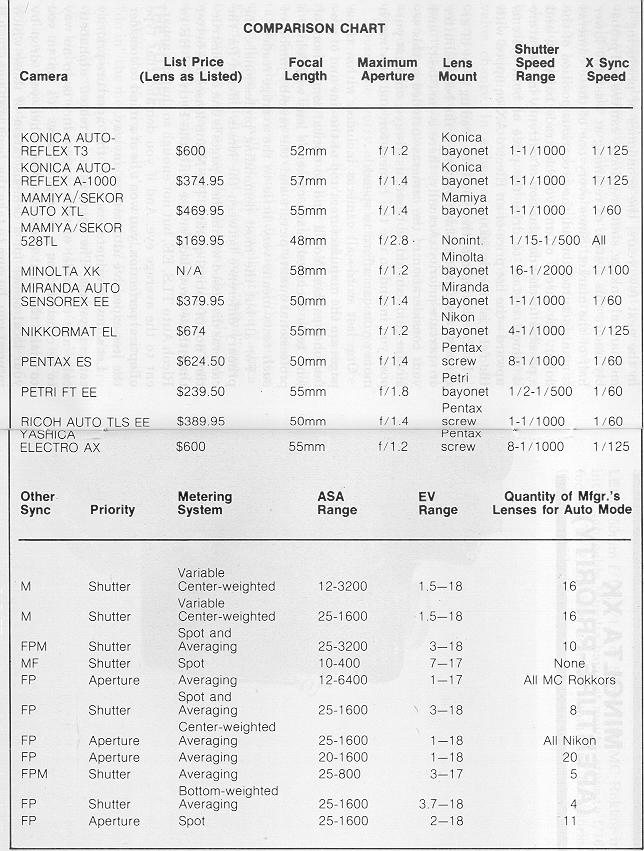
MINOLTA XK

(APERTURE-PRIORITY)
SPECIFICATIONS
CLICK ABOVE LIKE TO SEE MODEL
LENS/50mm f/1.7, f/1.4, or 58mm f/1.2 MC Rokkor in
interchangeable Minolta bayonet mount, stops to f/16, focuses to 21 inches,
accepts 55mm lens accessories (f/1.7 uses 52mm).
SHUTTER/Electronically governed focal plane with titanium curtains; speeds from
16 to 1/2000-second steps, 4 to 1/2000-second continuously variable; two
mechanically controlled settings (X&B); X & FP sync with single terminal and
switch; optional hot shoe on accessory mount. Self-timer with 10-second delay.
VlEWFINDER/Interchangeable pentaprism; choice of five finders from plain to Auto
Electro with each offering a different degree of sophistication in camera
application. Aperture, shutter speed/function scale, meter readout needle,
speed/function bar, LED exposure warning signal visible in Auto Electro finder.
Choice of nine focusing screens available.
EXPOSURE CONTROL/Automatically selects correct shutter speed when speed/function
dial is set to Auto position. Two CdS cells in Auto ElectrQ finder provide
Minolta CLC metering at full aperture with MC Rokkor lenses, stop-down metering
with other Rokkors. Auto Exposure stepless override from + 2 EV to -2 EV; meter
compensation scale in half-step graduations from -0.5 EV to + 3.5 TV. Adjusts
for film speeds between ASA 12 and 6400 and provides exposure range (ASA 100) of
EV 1 to 17 with f/1.2 lens. Powered by two 1.5-volt, S-76 silver oxide batteries
or equivalent.
FILM ADVANCE/110° ratchet-type after 20° unengaged movement of plastic-tipped
lever.
OTHER FEATURES/ Auto-Senswitch turns on Auto Electro finder, auxiliary finder
power switch, battery checker, film reminder, multiple exposure provision, long
exposure selector, eyepiece shutter control, mirror lockup/depth-of-field
preview button, progressive exposure counter resets when camera back is opened.
PHYSICAL DIMENSIONS/ 6 inches long, 4-5/16 inches high, 33/4 inches deep; weighs
1 lb. 15~/2 oz. (without lens).
MANUFACTURER/ Minolta Camera Co., Ltd., Osaka, Japan.
IMPORTER/ Minolta Corp., 200 Park Avenue South, New York, N.Y. 10003.
LIST PRICE/ To be announced.
TOP PHOTO OF MINOLTA XK

Reversing the position of the film advance lever and exposure counter on the XK
top plate would have made it a better fast-action camera, but all controls shown
are large and functional.
Minolta avoided the engineering difficulties of devising its own memory system
by licensing the same one Asahi uses in the Pentax ES, and with the lead time
thus saved, Minolta has produced what amounts to the most elaborate EE camera
system you can expect to see for some time to come--the Minolta XK. At the same
time, the XK turns out to be one of the most over-engineered cameras in recent
times. Let's take an inside look at what makes Minolta's bold challenge to Nikon
and Canon work.
The basic XK unit is the body. The standard Minolta bayonet lens mount is used,
and a 54° clockwise motion seats any MC Rokkor lens for full aperture through
the-lens viewing and metering. Other non-meter coupled lenses (including earlier
Rokkors) in Minolta mounts can be used for stop-down metering and viewing. Three
newly-designed Rokkor standard lenses with a rubberized waffle pattern focusing
grip are provided for XK use - the 50mm f/1.7, 50mm f/1.4 and 58mm f/1.2 - all
with Minolta's Achromatic (multi) Coating.
An oversize mirror prevents image cut-off when using long focal length lenses
and a movable damper arm at the inside top of the lens mount in the body
cushions the mirror's upward motion, reducing vibration and noise. A small
chrome button beneath the self-timer lever at the base of the body's lens mount
serves as a combination depth-of-field preview and mirror lockup device. When
pushed in, it locks for full aperture metering/viewing. To check depth-of-field,
depress the button and it pops out about 'A-inch. This position is also used for
stop-down metering. Twisting the chrome button to line up the red dots locks the
mirror up; if you wish to unlock it without taking a picture, just push the
button in toward the lens. In theory, it all sounds delightfully easy, but
operating that small milled button takes a bit of practice, especially when
twisting it for mirror lockup.
SEE FRONT VIEW

On the
opposite side of the mount, you'll find a PC terminal for flash and another very
small selector switch below it for sync adjustment - X sync in the upper
position, FP in the lower; it seems that it would have been just as practical to
provide separate terminals. The self-timer lever operates exactly as you'd
expect it to, but placed beside it is a vertical waffle-patterned strip which
Minolta calls its Auto-Senswitch. This is actually a microswitch that turns on
the XK's metering system whenever it's depressed, and this switch is placed on
the camera body precisely where the designers think the fingers of your right
hand should rest when holding the camera. Thus, picking it up in a shooting grip
will activate the meter with no other effort on your part.
But here's where one of the XK's delightful eccentricities comes into play.
Suppose the camera is set for auto operation (we'll come to that shortly) and
just as you depress the shutter release button, your grasp changes slightly,
breaking the microswitch contact-- what happens? Zing, the titanium shutter
curtain zips across the film plane and locks open! To close it, you must flip
the XK body upside down, insert a coin in the battery chamber cover and turn
from C to O to break the circuit. This can be a pain in the neck, especially to
the casual user of the camera. And breaking the microswitch contact is quite
easy to do since the switch is hinged at the top, traveling but a minute
distance to make or break contact. There is a way to avoid this when using the
Auto Electro finder, which we'll look at in a moment.
With no finder on the body, you have no way of setting the shutter speeds, since
the function dial. is an integral part of each of the five different finders
available, but before considering the viewing choice, let's look at the rest of
the top plate. The rewind crank is part of the XK's accessory mount and accepts
a hot shoe contact that locks in place by a small lever at the five o'clock
position. This lets you use a cordless flash with the XK, but the mount must be
removed before the film can be rewound; this hampers rapid film interchange in
the midst of a hot shooting session. Once you've removed the accessory mount,
rewinding is really a breeze because the crank handle operates in a 45° position
and provides plenty of room for fingers to clear the finder while giving a good
grasp. (Other manufacturers should take note of this feature!)
The film advance lever rides on bearings and is comfortably cushioned, swinging
out 20° before engagement and requiring another 110° stroke to complete the film
advance and shutter winding. The lever's hub is the shutter release button and
to the extreme right, you'll find the exposure counter.
A quick look at the XK's baseplate and then we'll get to the heart of the camera
- its automatic exposure system. A neat touch that others would do well to
emulate comes to light when you unlock the battery chamber cover by turning it
90°. Attached to the: inside of the cover is a small metal holder into which two
S-76 silver oxide batteries are positioned - no more fumbling with batteries to
drop them into the chamber correctly. You simply insert them in the holder and
lock it in place. A film type/exposure number indicator is located beside the
battery chamber cover, and following the trend toward easier rewind operation,
Minolta has provided a large cutout around the film advance release button. This
also serves a dual function in that it can be depressed (while you're operating
the film advance) to wind the shutter without advancing the film for multiple
exposures. Other SLR's use this same technique for intentional double exposures,
but with some it doesn't always work precisely - the film may move ever so
slightly, but with the XK, you needn't worry because it works perfectly.
SEE VIEWFINDER SHOT

Auto
Electro finder has meter coupling arm (1) that must be locked against the red
dot (2) before mounting to camera body. When fitted in place, the arm rides
against a lug on MC Rokkor lenses to program the system for the aperture you've
chosen.
As mentioned earlier, a choice of five interchangeable finders are provided for
use with the XK. The meterless Plain finder is an eye-level pentaprism with 0.8X
magnification, and it displays both shutter speed and aperture in the finder. A
Match-Needle finder contains two CdS cells in the pentaprism, measures light at
full aperture using Minolta's Contrast Light Compensator (CLC) system, and is
used as any conventional match needle equipped camera - the follower bar and
meter indicator needle are aligned to provide the correct exposure in an EV
range of 3 to 17 (ASA 100).
A waist-level finder with folding hood and swing-out magnifier (1X
magnification, -1.2 diopters) is available for low- or right-angle viewing. Or
you can select a high-magnification finder for critical focusing in closeup and
macro work. This magnifies the entire field of view 6.20X, has a rubber
cushioned eyepiece, and contains a built-in dioptric adjustment from + 3 to -5
diopters.
The full potential of the XK however, is utilized only when equipped with the
Auto Electro finder. This contains all the necessary circuitry for electronic
timing and release of the shutter, and its measuring range extends from EV 1 to
EV 17, an excellent performance that lives up to Minolta's specifications in
actual practice. Various special circuits combine data about film speed and lens
aperture with information provided by the twin CdS cells of the CLC system to
electronically govern the XK's shutter. When locking the Auto Electro finder in
place, the meter coupling arm beneath its front must be moved across the finder
bottom until it clicks into place beside a fixed red dot (see picture). This is
very important, as the arm operates against a lug on the rear of the MC Rokkor's
aperture ring and is the only way the finder's meter has of knowing which
aperture you've selected. The finder can be positioned without latching the arm,
but all meter readings will be erroneous.
Fitting the finder in place via the single front and two rear locking pins is
accomplished by pushing it straight down until the pins click. You set ASA film
speeds from 12 to 6400 with a large milled knob atop the finder - an ASA/Din
conversion chart is an integral part of the camera back and is useful when
foreign emulsions not rated in the ASA system are used. A compensation factor
selector on the film speed dial alters the meter's sensitivity to compensate
when using certain focusing screens and/or lenses. Positioning the finder
couples the shutter speed dial to the camera, and now you'll see shutter speeds
ranging from 1 to 1/2000-second, a B setting for time exposures, an X setting
for flash sync, and the word "Auto." When Auto is aligned with the dot on the
finder, the XK is set in automatic mode and the shutter is governed
electronically through a continuously variable or stepless range of 4 to
1/2000-second.
SEE BACK OF CAMERA

Small milled knobs on either side of the tinder eyepiece operate the
auxiliary meter switch (1) and viewfinder shutter blind ( 2), but the knob faces
are not well affixed; remove and re-cement to prevent their loss.
A long-exposure selector lever at the base of the shutter speed coupling dial on
the camera top plate provides manual selection of electronically governed speeds
from 2 to 16 seconds. There's also a thumb-controlled auto exposure override
device protruding from the back of the shutter speed dial. This manually adjusts
the automatic exposure in a stepless range from 2 EV under to 2 EV over
the metered value, but it must be held in position as the shutter release button
is depressed. The marked speeds of 1 to 1/2000-second are used whenever the XK
is working in a match-needle mode.
The film advance locks when battery voltage is insufficient, and the XK shutter
can then be operated mechanically but only on the B or X setting. Since X
represents 1/100-second, you can shoot at that speed with dead batteries -
surely a more practical choice than the 1/1000-second of the Yashica ElectroAX.
Incidentally, a battery check switch located on the left side of the top plate
contains a small red signal light to indicate battery condition.
At the back of the finder on either side of the eyepiece is a small milled dial.
The right one is an eyepiece shutter control and when it's turned in the
direction of the arrow, it moves two pieces of metal together that are
positioned in front of the eyepiece lens, shutting off external light from
entering the finder to disrupt meter readings during lengthy exposures. The
other dial is an auxiliary meter off/on switch that can be used instead of
relying on the Auto-Senswitch. Using this auxiliary switch will prevent the
aforementioned shutter problem if the Senswitch is released accidentally while
making the exposure, but it's easy to forget that it's on. Minolta intends its
use primarily for long exposure control when the camera is tripod-mounted, since
the Auto-Senswitch is not activated under such conditions. A word of caution
here the faces of these dials are poorly secured in place with only a small dab
of glue, so you might want to carefully pry each out and re-cement them to avoid
the inadvertent loss of one or both.
A chrome finder release button to the left of the eyepiece on the back of the
top plate is depressed to remove the finder and/or focusing screen. Minolta has
made nine different screens available, although the camera is normally equipped
with a split image rangefinder center (Type P) screen that shows 98% of what
will appear on the film. The finder contains a display of the information
Minolta considers essential for using the XK. The lens aperture selected appears
at the top of the viewfinder frame in white and is also enclosed in a white
rectangle for easy recognition. The shutter speed scale with meter indicator
needle and speed/function bar is along the right. A Light Emitting Diode (LED)
acts as an exposure warning signal and pulsates whenever lighting conditions
fall below the meter's lower operating limits.
As long as you observe its little eccentricities, the XK will perform
flawlessly, but for many photographers not accustomed to such a complicated
looking device, this might prove to be its downfall. Minolta clearly intends the
XK to challenge the Nikon F2 and Canon F1 as a professional system camera and
lists 107 accessories, including 30 lenses. Whether the XK will lure Nikon and
Canon users to its fold is debatable, as both have their own SLR EE model that's
completely compatible with their present lens and accessory listing, and how
well the XK will fare with non-professionals in view of its price, is still to
be determined. For readers presently equipped with a Minolta SR 101 or 102, it's
a natural upgrade, especially if you've already invested a healthy sum in MC
Rokkor lenses.
How did we like the camera? Well, opinion was split among Photographic
magazine's editors concerning the ease of using it, but there's no doubt that
the XK is an extremely capable instrument. Obviously a lot of thought went into
the XK design, but an on-going program of modifications will probably take place
during its production run. If you have an extensive number of Minolta
accessories and/or lenses, can afford the tariff, and are willing to be tolerant
of its small quirks, as well as some undersize but overmilled knobs and buttons,
this should prove to be more camera than you'll ever use. But it's also one
camera you're going to have to play with a bit before you can decide whether or
not you want to part with the money. Minolta originally scheduled the XK for
U.S. introduction in early 1973; it now appears that you won't be able to
purchase one until at least April 1974 - that should give you a head start in
saving your money for this one!
MINOLTA MC ROKKOR LENSES CONSTRUCTION
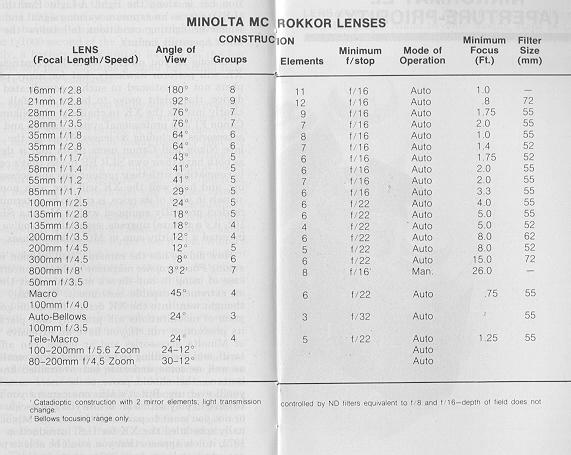
NIKKORMAT EL
(APERTURE-PRIORITY)

SPECIFICATIONS
LENS/50mm f/2 or f/1.4, 55mm f/1.2 Auto-Nikkor in interchangeable
Nikon bayonet mount, stops to f/16, focuses to 24 inches, accepts 52mm lens
accessories.
SHUTTER/Electronically governed metal blade Copal Square ES with speeds from- 4
to 1/1000-second and B. Has MX sync with side terminal and hot shoe. Self timer
with 9-second delay.
VlEWFINDER/Fixed pentaprism with central microprism, fine focusing collar, and
full focusing screen. Shutter speed scale, over/underexposure indicators, meter
readout needle, exposure mode indicator, match needle bar visible.
EXPOSURE CONTROL/Automatically selects correct shutter speed when shutter
speed/function dial is set to "A" position. Two vertically mounted CdS cells in
pentaprism read center-weighted area of viewing screen at full aperture. Manual
override. Automatic exposure hold lever. Adjusts for film speeds between ASA 25
and 1600 and provides an exposure range (ASA 100) of EV 1 to 18. Powered by
6-volt #544 silver oxide battery or equivalent. .
FILM ADVANCE/140° ratchet-type after 30° unengaged movement of plastic-tipped
lever which activates meter.
OTHER FEATURES/Battery check button and light, sync switch, depth-of-field
preview button, mirror lockup provision, dual safety latch on camera back,
progressive exposure counter returns when back is opened.
PHYSICAL DIMENSIONS/5 3/4 inches long, 3 3/4 inches high, 3 7/8 inches deep;
weighs 1 lb. 13 oz. (without lens).
MANUFACTURER/Nippon Kogaku, Japan.
IMPORTER/Ehrenreich Photo-Optical Industries, Inc., 623 Stewart Avenue, Garden
City, N.Y. 11530.
LIST PRICE/$540 with f/2 lens, $624 with f/1.4 lens, $674 with f/1.2 lens. Add
$18 for black body. (Prices approximate at publication.1972)
SEE TOP OF CAMERA

Smooth, clean lines of EL make this the choice Nikkormat model to date; shutter
speed dial is now conventionally located on top plate and everything falls
easily In hand - you won't find any 35mm SLR EE camera that tops the silky
operation of this one.
Nippon Kogaku's new EL model is one of the most carefully thought out approaches
to exposure automation currently available. Its designers have an enviable
record of scoring with their cameras, and the EL turns out to be their latest
success, as they have managed to redesign the Nikkormat body in the image of the
Nikon F2 without losing the exact "feel" that owners have come to expect and
appreciate. If you already own an FTN, take it along with you to your dealer for
a look at the EL - you'll be surprised at just how closely the two cameras are
in handling and feel, despite the many changes evident in the EL.
The EL body redesign eliminates the sharp corners of the FTN, and the prism
profile has been lowered and reinforced internally to accommodate a hot shoe for
flash. The film advance lever has been reshaped and given a molded plastic tip,
which should fit nicely into that groove worn in most FTN users' thumbs by the
older style lever. At the same time, body weight has been reduced by one full
ounce, no mean feat when you consider the size and weight of the 6-volt silver
oxide battery that powers the meter and shutter.
Examining the EL for the first time, FTN owners will notice two distinct
features immediately - one old and one new. The external lens indexing pin and
prong system has been retained to permit the use of all past and present Nikon
lenses. While this has traditionally been a point of debate between those who
like the Nikon system and those who don't, you can appreciate the fact that the
EL's designers put their customers' interest ahead of making all previous lenses
for full aperture use obsolete by not adopting an internal indexing system.
Noting this, you'll then find that the shutter speed ring on the lens mount is
gone, having been replaced by a conventional dial located in the traditional
spot on the top plate.
There are several other small touches that have been added a white battery check
button placed next to an amber check light on the back of the top plate, moving
of the depth-of-field preview button to the camera's front, a redesign of the
mirror lockup lever to make it more functional, and the addition of steel
inserts in the strap lugs to reduce wear.
The ASA index dial has been moved from its awkward position beneath the FTN's
lens mount; it now surrounds the rewind knob and works with a lock tab to
prevent changing the film speed inadvertently. Another small lug on the ASA dial
must be pushed before the rewind knob can be pulled up to open the camera back,
providing a safety factor against accidental opening. As we'll see, the dual
function approach has been applied to EL design in several ways.
The shutter speed dial on the opposite side of the pentaprism housing is
sufficiently large for easy operation, although the numbering is a bit on the
small size, making its use in low light situations somewhat difficult. The dial
is marked with speeds from 4 full seconds to 1/1000, B and A. When set on the A
or automatic position, it locks in place and can be moved to a manual mode only
by depressing the small chrome hub. A lift-up outer collar is used to switch
flash sync from X to M and controls both hot shoe and PC terminal, which is now
threaded to use the screw-on Nikon sync cord. With a dead battery, the Copal
Square ES can be used mechanically at 1/90-second only.
Positioned just right to take advantage of the redesigned film advance lever,
the large shutter release button is silky smooth in its operation. Pulling the
advance lever out 30° turns on the metering system and another 140° advances the
film and winds the shutter. Once you've finished shooting, pushing the lever all
the way back turns off the meter and locks the shutter button. Directly in front
of the lever's hub, you'll find the exposure counter set beneath a small
rectangular window.
Now back to the dual function controls. Push the self-timer lever to the right
and it fires the shutter after the center release button is depressed; push to
the left and you can lock the metering system for up to 10 minutes. This is
handy for close-up readings of unusually lighted subjects, but don't let that
moving meter needle fool you; as long as the locked reading is held, the meter
is disconnected from the exposure circuit.
SEE ASA INDEX

The ASA index dial is now placed beneath the rewind knob and actuated by small
lever; the other lever acts as a
safety lock for the camera back to prevent it from opening it the
rewind knob is accidentally pulled up.
Nikkormat FTN owners will find little change in the metering
system; twin CdS cells provide a center weighted reading of the entire picture
area, just as in previous Nikon cameras. The difference here is that the cells
have been positioned vertically near the eyepiece instead of horizontally. This
reduces the possibility of stray light entering the eyepiece and affecting the
meter's performance. The metering circuit governs the Copal Square ES
focal plane shutter, offering fully automatic and electronically governed speeds
through a stepless range from 1/1000 down to 4 full seconds.
The EL comes equipped with a 4mm central microprism in the focusing screen but a
split-image rangefinder is available on request. You'll see 92%
of the picture area but not the Fresnel lines seen on the FTN's screen; screen
redesign lets you use the entire area for focusing if desired, and those who
wear glasses will have little trouble seeing the entire area. Unlike other SLR
EE cameras, the viewfinder's data display is on the left side and consists of a
shutter speed scale, meter readout needle, and transparent red
over/underexposure warnings marked A and B. A transparent green needle covers
the A when the EL is used in automatic mode, doubling as a part of the
match-needle system when the camera is operated on manual. The B indicates that
an exposure of more than 4 seconds is necessary and that the shutter will remain
open as on a Bulb setting. In such cases, close the shutter by turning the speed
dial from its A position to one of the marked speeds.
The instant-return mirror is now longer, an
improvement made possible by redesigning the mechanism's rotational axis, and
lets you use long lenses without cutoff. At the same time, the dampening system
was altered to minimize vibration during exposure. Examining the well baffled
mirror box would never reveal that the huge 6-volt battery used to power the
automated exposure system was stored inside, but lift the mirror and you'll find
a spring-loaded cover on the bottom of the chamber. Pop it open and there's the
battery. While this solves the problem of battery storage neatly, it does make
changing the power supply a bit more difficult than the usual slotted external
compartment cover. But users shouldn't worry about the inconvenience - how often
do you fuss with the battery?
Optically, the Nikkormat EL is essentially the same as the FTN, but a couple of
improvements should be noted. The five-group, seven-element lens is the same
formula available on recent FTN models but it's been multicoated (note the
engraved "C" on the front ring) and a seven-blade diaphragm substituted for the
older six-blade design. This will serve to change the configuration of sun
images as well as to soften out-of-focus highlights. Multicoating considerably
reduces ghost images and flare, and should be welcomed by all serious EL users.
How does the camera compare with its competition? Very favorably. Nippon Kogaku
has had a great deal of experience producing superb quality cameras, and
considering that the EL is really a new design, despite its remarkable retention
of the Nikkomat image, it's a considerable achievement in design evolution and
refinement. That soft, silky shutter button movement is much improved over the
FTN release, and will be appreciated by all who use it.
SEE SHUTTER SPEED DIAL

The large shutter
speed dial is easy to operate but legibility of the numbers could be improved
for use under low light level conditions.
The camera's finish and workmanship are superior to those of previous Nikkormat
models and reaches into the level of the Nikon F series. If you presently own an
FTN, you'll be pleased at the favorable comparison between the two cameras and
delighted at the improvements; if owning a Nikkormat has been your ambition,
this is the model to aim for now.
SEE LISTING OF AVAILABLE NIKKOR LENSES
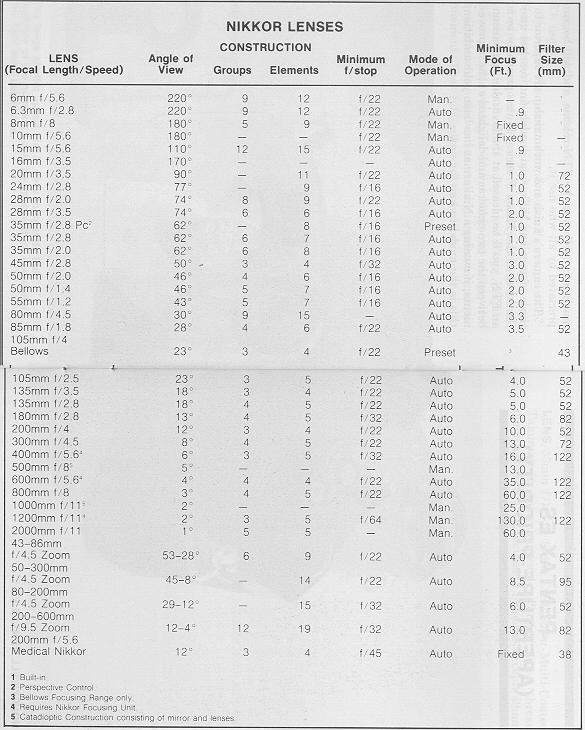
PENTAX ES
(APERTURE-PRIORITY)
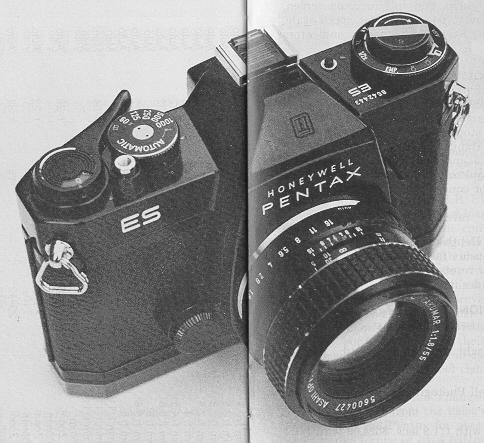
SPECIFICATIONS:
LENS/55mm f/1.8 or 50mm f/1.4 Super-Multi-Coated Takumar in
interchangeable Pentax screw thread mount, stops to f/16, focuses to 18 inches,
accepts 49mm lens accessories.
SHUTTER/Electronically governed rubberized focal plane with speeds from 8 to
1/1000-second on Auto setting or 1/60- to 1/1000-second (5 speeds), and B on
Manual setting. FPX sync with hot shoe contact and front terminals.
VlEWFINDER/Fixed pentaprism with central microprism, fine focusing collar and
full focusing screen. Magnification at infinity: 0.89X. Shutter speed scale,
battery check signal, over/underexposure indicators visible.
EXPOSURE CONTROL/Automatically selects correct shutter speed from infinitely
variable range when selector is set to Auto. CdS cells on each side of finder
eyepiece read entire picture area at full aperture with SMC Takumar lenses; at
stopped-down aperture with any Pentax thread lens. Manual override. Adjusts for
film speeds between ASA 20 and 1600 and provides exposure range (ASA 100) of EV
1 to 18. Powered by 6-volt, #544 silver oxide battery or equivalent.
FILM ADVANCE/170° ratchet type.
OTHER FEATURES/Depth-of-field preview lever, battery test button, exposure
factor control dial, progressive exposure counter resets to "0" when camera back
is opened, film reminder indicator.
PHYSICAL DIMENSIONS/5/2 inches long, 4 inches high, 3 1/2 inches deep; weighs 2
lbs. 1 oz.
MANUFACTURER/Asahi Optical Co., Ltd., Tokyo, Japan.
IMPORTER/Honeywell Photographic Products, Littleton, Colo. 80120.
LIST PRICE/$574.50 with f/1.8 lens, $624.50 with f/1.4 lens. Black body is
standard but chrome body is available at $318.17 (minus lens).
SEE TOP OF CAMERA

As
slight pressure on the shutter button turns on the meter when SHUTTER dial is
set to Automatic position, ES should be set on a marked speed when carrying in a
foam-padded case to prevent rapid battery discharge.
As the first of the new SLR EE cameras equipped with an electronically governed
focal plane shutter, the Pentax ES sent a host of the competition's designers
scurrying back to the drawing board, and thus reaped the benefits of being first
with the most. Impressive as the achievement was, packaging this bold new
approach to automatic exposure control in a body virtually identical in size and
weight with previous Pentax cameras is also quite a feat. While other
manufacturers have found it necessary to produce what amounts to entirely new
body configurations for their EE models, those accustomed to the handling and
operation of the traditional Pentax design will feel right at home with the new
ES.
There have been a few changes, but all are minor and none detracts from the
basic ease of use that has characterized the Pentax for over a decade. The
self-timer is gone, replaced by a battery housing that protrudes about l/2-inch
from the front of the camera body. Unscrewing the front of the housing allows
access to the #544 silver oxide battery, and a tiny button on the top plate left
of the pentaprism housing serves as a battery check switch. But don't look for
any bright lights to blink the battery's condition; such a gaudy display is
totally out of keeping with the camera's basic conservatism. A deflection of the
meter readout needle accomplishes the same thing--and you don't even have to
remove the camera from your eye.
Just to confuse the issue, Honeywell announced, that a Pentax ES II will be
available shortly. Designers have restored the self-timer to the ES II in its
traditional position presently occupied by the battery chamber on the original
ES. The ES II has a blind built into the viewfinder to prevent extraneous light
from entering the finder eyepiece during long exposures and uses four 1.5 volt
batteries relocated to the camera's base. Its price will be somewhat higher than
that of the ES presently, but by how much is not known at this writing.
The ASA index control has been moved from the shutter speed dial to a collar
surrounding the rewind knob. The collar also serves as a limited override on the
metering system to adjust exposure for unusual lighting conditions and can be
used to provide AX, 2X or 4X, the exposure determined by the meter. The collar
is left in the 1X position under normal lighting conditions. The shutter speed
dial is marked with five mechanical speeds from 1/60- to 1/1000-second and B.
and an Automatic position.
The ES shutter has the virtue of not requiring battery power when set on a
marked speed, and so it's possible to use the camera manually with all five
shutter speeds even if the battery is dead. This is certainly more useful than
being locked into the use of a single speed as with the Yashica Electro AX or
Minolta XK. But the meter is disconnected when you use mechanical speeds, and it
will not give a reading--there's no match-needle capability (nor is one
necessary) with the ES. Everything else about the camera is strictly
Pentax--handling, controls, metering system, etc.--and familiar to anyone who
has previously used a Spotmatic.
For the benefit of those who are not acquainted with the time-proven Pentax
design, here's a brief rundown. The metering system uses CdS cells placed on
each side of the eyepiece to read the entire viewing area at full aperture with
SMC Takumar lenses--at stop-down aperture with all other automatic Pentax thread
lenses. To use the latter, you must push upward on a large switch at the left
side of the pentaprism housing. This stops the lens down to the shooting
aperture and also serves as the depth-of-field preview switch when shooting at
open-aperture with automatic lenses, but the shutter remains electronically
governed. If full aperture operation is important to you and you intend to use
the camera primarily with a zoom lens, be advised that the Pentax SMCT zoom
lacks the full aperture pin and must be used in a stop-down mode. This is also
true of the 85mm f/1.9 SMC Takumar.
To operate the metering system, all you need do is turn the shutter speed dial
to its Automatic position and slightly depress the shutter release button. Look
through the viewfinder and you'll see a full focusing Fresnel screen with the
usual central microprism surrounded by a fine focusing collar. The ES can be
ordered with one of four other screen types (including a split-image), or you
can have your choice installed at a later date by factory service centers at a
nominal cost of $25. (A lock-up mirror modification is also available at $40, or
$30 if done when a screen is installed.)
Along the right side of the screen, you'll find a shutter speed scale marked
from 1/1000- to 1-second (the ES will govern speeds down to 8 full seconds with
accuracy) and meter readout needle. This is the least complex "control center"
used by any SLR EE manufacturer-- no colored areas or blinking lights. At the
extreme right side of the shutter speed scale, there are three cutout areas. The
top and bottom cutouts indicate over/underexposure, while the central one is a
deflection area in which the readout needle will indicate battery condition when
you depress the check button.
SEE ASA CONTROLS
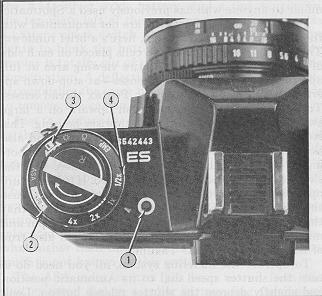
Left side OF ES top plate is a busy affair, with battery check button (1), ASA
film speed window (2), film type indicator (3) and exposure override (4)
surrounding the rewind knob.
The metering circuit turns off automatically once the shutter has been tripped,
and will not be reactivated until the release button is slightly depressed for
the next exposure, a handy feature that prevents accidental battery drain. Those
accustomed to winding the film immediately after taking a picture will not have
to readjust their technique as they would with cameras like the Mamiya Auto XTL,
whose film advance lever turns on the meter. There is, however, one precaution
to be taken, especially when carrying the ES in a gadget bag or foam-padded
case. If the shutter release button is depressed slightly either by pressure of
the foam or an accessory that might shift its position in the bag, the metering
circuit will be turned on and a fresh battery will die completely within 24
hours. To prevent this, always turn the shutter speed dial from Auto to 1/1000
when shooting is finished, and remember to return it to the Auto setting when
preparing to take pictures at a later time.
The SMC Takumar lens provided with the ES uses a new rubberized focusing ring
with a waffle pattern, and the milling on the aperture ring has been coarsened
for a better grasp, but other than these two changes, the lens remains the same
design as used by other current Spotmatic models. However, you cannot use a
standard lens from other Pentax models on the ES because of slight differences
in mechanical design. When mounted to the ES, the Auto/Manual selector lever of
the SMC Takumar lenses must remain in the Auto position and cannot be moved; the
depth-of-field preview switch is used to provide the stop-down aperture instead.
The slim and compact Pentax profile will appeal to many who have not previously
worked with the camera, especially when it's compared to other and more bulky
SLR EE cameras. Like the Nikkormat EL, Asahi has managed to retain the flavor of
past Pentax design in the ES and, despite the apparent simplicity of the camera
in appearance and operation, it has already proven extremely popular with those
looking for exposure automation in a top-quality 35mm camera. I specifically
mention the "apparent simplicity," as the Pentax has never been adorned with
flashing lights, multi-colored viewfinder signals, etc., and those seeking such
touches might consider the ES as somewhat stark by comparison to other SLR EE
cameras.
But in this case, appearance is deceiving, and as the first of the
aperture-priority SLR's to be marketed, it has been the standard by which others
are compared. From the aspects of quality, workmanship, capability, and ease of
operation, the ES with its proven and accurate metering system may be equalled
by the competition, but it is doubtful that any of the first generation
electronically governed cameras will exceed it in these respects.
SEE PENTAX ES LENSES
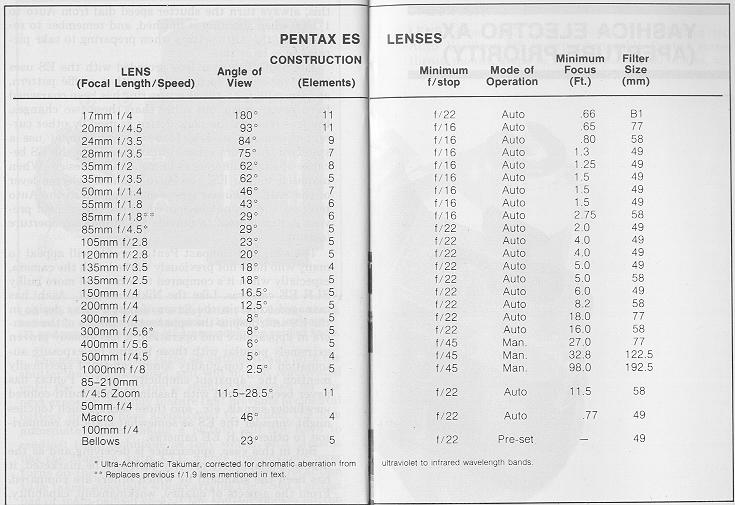
YASHICA ELECTRO AX
(APERTURE-PRIORITY)
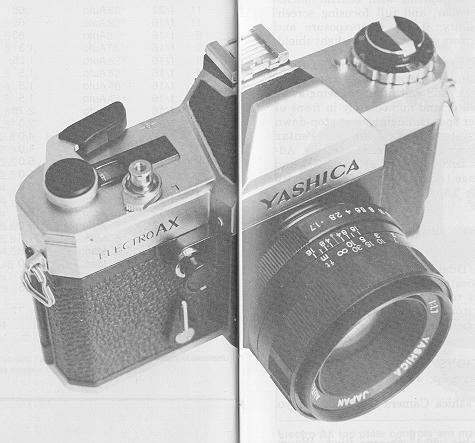
SPECIFICATIONS
LENS/50mm f/1.7, f/1.4 or 55mm f/1.2 Multicoated Auto Yashinon-DS
in interchangeable Pentax screw thread mount, stops to f/16, focuses
to 20 inches, accents 55mm lens accessories.
SHUTTER/Metal Copal Square (vertical travel) electronically governed focal plane
with speeds from LT (approximately 8 seconds) to 1/1000-second on Auto setting
or 1 to 1/1000-second (11 speeds) and B on Manual setting. FPX sync with hot
shoe contact and lens mount terminals. Self-timer with 8-second delay.
VlEWFINDER/Fixed pentaprism with central microprism, fine focusing collar, and
full focusing screen. Magnification at infinity: 0.87X. Overexposure and slow
speed warning arrows visible. Eyepiece light shield.
EXPOSURE CONTROL/Automatically selects correct shutter speed from infinitely
variable range when selector knob is set to
Auto. CdS cell fitted to swing-away arm behind mirror center and
immediately in front of film plane reads center spot through lens at stop-down
aperture. Metering system works with any Pentax thread lens in stop-down mode.
Manual override. Adjusts for film speeds between ASA 25 and 1600 and provides
exposure range (ASA 100) of EV 2 to 18 with f/1.4 lens. Powered by 5.6-volt,
PX32, E164 or equivalent mercury battery.
FILM ADVANCE/180° single-stroke, plastic-tipped lever.
OTHER FEATURES/Dual-lock back cover, battery check lamp incorporated in
progressive exposure counter that returns to Start
when camera base is opened, shutter indicator lamp on camera top, aperture
activator button to open lens to full aperture, shutter release lock.
PHYSICAL DIMENSIONS/5-15/16 inches long, As inches high, 37/s inches deep;
weighs 2 Ibs. 4 oz.
MANUFACTURER/Yashica Camera Co., Ltd., Tokyo, Japan.
IMPORTER/Yashica Inc., 50-17 Queens Blvd., Woodside, N.Y. 11377.
LIST PRICE/$460 with f/1.7 lens, $510 with f/1.4 lens, $600 with f/1.2 lens.
SEE TOP OF CAMERA
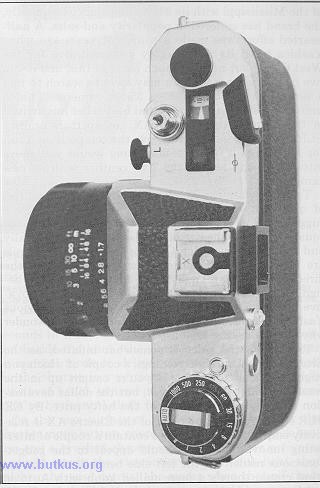
Electra AX top plate controls are massive In tradition of Mamiya/Sekor Auto XTL,
making the camera easy to use; there's plenty of room to operate everything.
Unlike other Japanese camera lines which have achieved a good market penetration
across the United States, Yashica has never really made an impact west of the
Mississippi with its 35mm line and consequently, the brand has suffered in
popularity and sales. A halfhearted effort was made a couple of years ago when
Yashica hired its first factory representative for the West Coast, but nothing
much came of this, and if you live in a western state, you may have to search to
find a dealer who stocks Yashica 35mm cameras. This is unfortunate, because a
potential best-seller has arrived in the form of the Electro AX, an
aperture-priority SLR that could conceivably give the competition a run for its
money if Yashica marketing would just move into the second half of the 20th
century with its new camera.
To begin with, the Electro AX has the look and feel of quality, fulfilling the
visual impression that it's a rugged piece of equipment. Like the Mamiya XTL,
the squarish body is heavy but falls into hand naturally and once there, you
don't notice the weight. Controls are logically placed and seem a genuine step
in the direction of human engineering applied to camera design. As a whole, this
most sophisticated of an innovative line of 35mm SLR's is less cluttered than
previous Yashica designs, almost to the point that you wonder why they're asking
$600 list for it.
Truthfully, the price is somewhat inflated, as the Electro AX has its
shortcomings, a couple of which you might consider as serious if you're caught
up in the craze to be first with the latest, but the dollar devaluation is
partially responsible for the hefty price. By EE SLR standards, the top plate of
the Electro AX is relatively empty, although it does contain a couple of
interesting innovations that should appeal to the gadget conscious reader. At
the left side beneath the film rewind crank, there's a large milled knob with
Auto in red letters and 11 shutter speed markings plus B (all click-stopped) in
silver. When set in the Auto position, the AX shutter is electronically governed
from 8 full seconds to 1/1000-second.
SEE TOP OF CAMERA
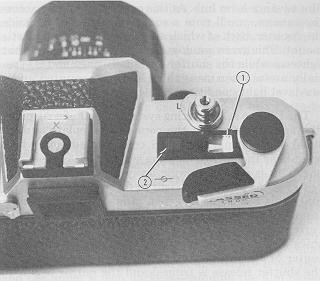
Depressing the battery check button illuminates the exposure counter window (1),
a helpful feature when shooting under low light conditions. The green window
beside the counter (2) lights up for the duration of shutter operation to
provide visual indication when long exposures are completed.
By depressing the small button beside the knob, the shutter can be switched
over to manual mode to deliver the stated 11-speed range. As the shutter is a
vertical-travel Copal Square, flash sync is at 1/125- instead of 1/60-second,
which is common to horizontal cloth focal planes.
On the rear surface of the top plate just below the shutter mode button, there's
a slightly larger black button and a brushed chrome switch. The latter activates
a shield inside the viewfinder to shut out light that might otherwise detract
the meter when the self-timer is being used. The black button marked C is a
battery check which also illuminates the large and easy-to-read green and white
exposure counter positioned beside the film advance lever hub. As this carries
us visually across the camera, you'll note a square green window beside the
counter, both of which are framed in a black plastic mount. This green window is
an operational signal that lights up while the shutter is actually open, and is
especially useful when using the AX tripod-mounted under low-level light
conditions.
The Electro AX metering system is a bit of a surprise; film speeds are set on
the camera's baseplate and instead of the usual twin CdS cells located somewhere
on or near the mirror/focusing screen, the AX uses just one. This is part of a
swing-away arm just behind the center of the mirror and right in front of the
film plane. Since this technique has been around for some time-- from Bolex
movie cameras of some years back to the current Leica M5--it's not new by any
means, but Yashica has added a different twist by semi-silvering the center of
the mirror to let light strike the cell. When the shutter release is tripped and
the mirror begins to rise, the meter cell or sensor arm drops into a recess at
the floor of the mirror box to clear the film plane for exposure. A
spring-loaded flap attached behind the mirror at the bottom folds back during
exposure to cover the semi-silvered part of the mirror and prevent any stray
light from finding its way through the viewfinder eyepiece and pentaprism to the
film's surface. Incidentally, the mirror box is neatly blackened with a
felt-flock material that keeps stray light and glare to a minimum; a most
effective touch, but don't let it get too dirty because the flock is hard to
keep clean.
Once you've pressed the shutter release button, the exposure data provided by
the CdS sensor cell is transferred to the IC brain which computes the precise
exposure required. Yashica uses a flexible printed circuit draped over the
pentaprism to transmit the information, which should lower the cost of repairs
if they should become necessary.
In keeping with Yashica's previous designs, the view finder is devoid of scales,
needles, and other such adornments. When the camera is set in the automatic mode
a red warning arrow lights up at the right side of the finder when the shutter
release is depressed; if the aperture you've selected will result in an
overexposure, simply select a smaller f/stop. If the shutter speed chosen by the
camera is 1/30-second or below, a yellow arrow lights up, warning you to use a
tripod or other steady support during exposure.
Now let's look at what might be considered limitations built in by Yashica.
While the rest of the photographic world is madly clamoring to climb aboard the
open-aperture metering bandwagon, Yashica has chosen to remain with the
stop-down method. That's right--look through the viewfinder and you'll see a
nice bright image on its Fresnel screen. The central microprism is one of the
best, and the fine focusing collar is super large. But throw the film advance
lever 180° and the finder screen darkens--winding the film closes down the lens
diaphragm to the f/stop you've preselected, negating the prime advantage of a
modern SLR--its bright viewing screen.
If you forgot to focus before winding the film, or wish to check focus (or even
framing) under dim light conditions, you can open the aperture by pressing
inward on the large aperture activator button. It operates easily and the lens
stays open as long as pressure is applied--a sort of depth-of-field preview
control in reverse. Learn to use the second finger of your right hand for this
chore, keeping the index finger on the shutter release. It's not really what the
serious photographer would consider an asset, especially since it's an approach
180° from that to which we've become accustomed, but you do become used to it
after awhile.
This also affects lens interchange. If you've already wound the film and then
wish to switch to another lens, you should hold the activator button in while
unscrewing one and mounting the other - it's best to switch before winding the
film because you can do so without worrying about the activator switch. The
question, of course, is just why Yashica chose to buck the current trend toward
open aperture metering. The only answer that makes sense is that the entire
range of Yashinon lenses can be used with the Electro AX without modification -
certainly a boon to those who already own a number of them, as well as a boon to
Yashica from a production standpoint.
SEE SIDE OF CAMERA
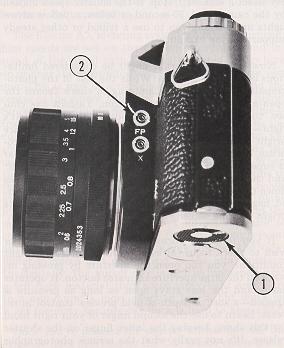
ASA
Speeds are set with this base plate dial (1) beside the battery chamber cover.
Flash terminals (2) are body mounted beneath the pentaprism.
Any auto diaphragm Pentax thread lens will work with the AX exactly as would a
Yashinon DS lens, although you won't be able to open its diaphragm to full
aperture with the activator switch. Even non-auto lenses can be used with the
stop-down metering system of the AX. Like the Ricoh Auto TLS EE, the Electro AX
possesses nearly unlimited optical capabilities with the ubiquitous 42mm screw
thread lenses.
Should battery power fail, the camera can be operated in a mechanical mode, but
only at 1/1000-second, which is hardly a practical shutter speed for most
situations. Setting the camera to manual operation disconnects the meter, but
the shutter still requires battery power to function through the range - a
limitation not shared by other aperture-priority cameras, like the Pentax ES and
Nikkormat EL. Incidentally, the 5.6-volt PX32 mercury battery cell is one of the
largest power cells used to date in EE cameras.
So there you have it - a beautifully finished, excellent handling and expensive
SLR that shows considerable imagination in its design. If you can live with the
stopdown metering, and to a lesser extent, the prospect of a dead battery, this
one will deliver the goods and you'll enjoy every minute of it. And if you
already happen to own a couple of Yashinon lenses, the money you'll save by not
having to swap them in to get into the EE game will go a long way toward paying
for the AX.
SEE AVAILABLE YAHSINON DS LENSES
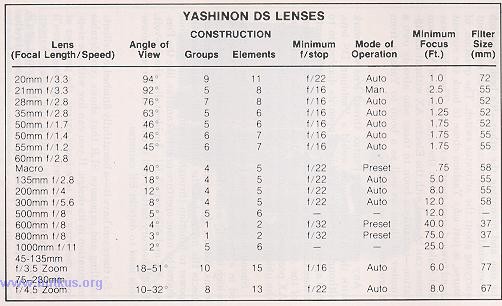
MORE ON THE WAY
As you might expect, there are more EE SLR s on the way; no manufacturer of a
major camera line can hope to compete today without one. The next model to
appear should be the EF from Canon sometime in 1974, an interesting hybrid that
will use the complete series of Canon FD lenses and seems to offer the best of
both worlds to potential customers - its shutter is mechanically controlled at
speeds between 1/8 and 1/1000-second, but electronically governed at slower
speeds ranging from 1/4 -second down to 30 full seconds.
The designers at Canon believe that the accuracy of an electronically governed
shutter is most useful during longer exposures, and by arbitrarily shutting off
the control above 1/4 -second, the EF possesses two distinct advantages of
interest. Since its energy requirements are less, smaller and less powerful
batteries are used. However, if they should fail, the shutter will continue to
operate within the full 1/8 to 1/1000-second speed range. Despite its part-time
electronic system, the Canon EF is considered to be a shutter-priority camera.
The contest between it and the Nikkormat EL is not likely to result in any major
changes in either s share of the SLR market.
Argus is presently prevented from distributing its Cosina EC-2000 in the United
States because of patent difficulties, but readers who live in Canada or travel
abroad may well run into this aperture-priority SLR. Purchase of one for use in
the U.S. would not prove a wise idea due to service and warranty problems that
would arise should the camera develop problems. But you can look for other
manufacturers to jump into the race in the coming months.
You can also look for a variety of minor improvements to make their appearance,
either on new cameras or second-generation models of those already available.
Industry observers already feel the CdS cell to be on its way out because the
silicon blue cell used by Fujica has a faster response to extreme changes in
light levels and does not go temporarily "blind" when exposed to a brilliant
light source.
It's also reasonable to anticipate that the LED concept as used in the Yashica
AX will find greater favor, both in the name of simplicity and lower
manufacturing costs. This will result in less cluttered viewfinders, which may
or may not be of benefit, depending upon how much you rely on the "control
center" approach favored by some cameras.
WHAT DOES IT ALL MEAN?
Primarily, the sophistication in camera design that's appearing now
means a higher initial cost, more expensive repairs when one system conks out,
and a greater likelihood that such system failure will occur. As each succeeding
generation of cameras becomes more complicated internally, repairmen find
themselves going "back to school" periodically just to keep up with the
fundamentals. Today's SLR models are packed with subsystems that often have an
intricate interdependence upon each other, and to locate and repair one that has
failed may require disassembly and removal of two or three other subsystems just
to reach the faulty one. Modular construction is bound to come, and the
manufacturer who can figure out how to pack everything necessary in a camera
body, yet make repairs a simple and inexpensive matter of replacement, is going
to have a very strong advertising point.
SHOULD YOU BUY ONE?
It's always very tempting to have the latest in equipment at your
fingertips, but with the increasing costs of 35mm SLR cameras these days, the
important point seems to be whether having the latest is economically practical
for you. Readers who only occasionally use their cameras are
probably wiser, from a financial standpoint, if they avoid the temptation to
"trade up" to the latest and most automatic of cameras. But for those who use
their cameras with some degree of regularity, there may be justification to
succumb to the temptation.
If you do buy, consider the investment that you already have in terms of lenses
and other accessories as a part of the decision-making process. If it means
buying an entirely new lens bank, perhaps you should consider alternatives in
the particular model you lean toward. On the other side of the coin, you should
also look at the number and kind of accessories provided by the manufacturer of
the camera you are considering - are the ones you'll want to use available, or
will you end up with a much more expensive camera and be forced to use
accessories that do not utilize the camera's full capabilities?
- CLICK HERE TO SEE VIEWFINDER INFORMATION FOR
MINOLTA -
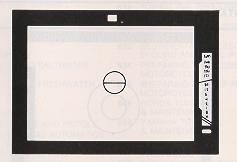
- FOR NIKKORMAT EL,
PENTAX ES, YASHICA ELECTRO AX -
